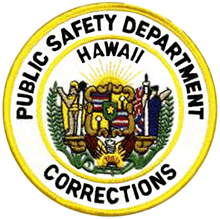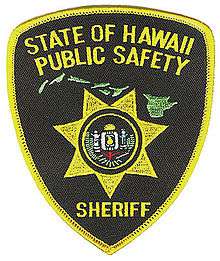Hawaii Department of Public Safety
| Hawaii Department of Public Safety | |
|---|---|
| Abbreviation | HDPS |
| Agency overview | |
| Employees | 2,263 (as of 2006) |
| Legal personality | Governmental: Government agency |
| Jurisdictional structure | |
| Operations jurisdiction* | State of Hawaii, USA |
| Size | 10,931 square miles (28,310 km2) |
| Population | 1,283,388 (2007 est.)[1] |
| General nature | |
| Operational structure | |
| Headquarters | Honolulu, Hawaii |
| Deputy Sheriffs Narcotics Enforcement Agents | 244 |
| Agency executive | Nolan Espinda, Director |
| Facilities | |
| Prisons | 4 |
| Jails | 4 |
| Website | |
| http://hawaii.gov/psd | |
| Footnotes | |
| * Divisional agency: Division of the country, over which the agency has usual operational jurisdiction. | |
The Hawaii Department of Public Safety is a department within the executive branch of the government of the U.S. state of Hawaii. It is headquartered in Room 400 in the 919 Ala Moana Boulevard building in Honolulu, Hawaii.[2] The Department of Public Safety is made up of three divisions.
Divisions
Administration
The Administration Division provides support services that enable the corrections staff to fulfill their responsibilities. Some of these services include training and staff development, fiscal and personnel management, management of the operating budget and capital improvements program budget, procurement, and management information systems and research.[3]
Corrections

Prisons
The Corrections Division oversees four prisons. Three of the prisons are located on the island of Oahu and one on the island of Hawaii.[4] They include:
- Halawa Correctional Facility
- Waiawa Correctional Facility
- Women's Community Correctional Center
- Kulani Correctional Facility in Hawaii County, on the Island of Hawaii, which was closed in 2009 [5][6] and reopened in 2014
Private prisons
In 1995 the State of Hawaii began contracting with prisons outside of Hawaii to house Hawaiian prisoners.[7] The criteria for sending inmates to private prisons on the mainland include a minimum sentence of 24 months, a lack of pending criminal cases in Hawaii, and a lack of major health and medical issues. Daphne Barbee, an attorney, said that she had clients with cases pending who were sent to the mainland anyway.[8] According to Kevin Dayton of the Honolulu Advertiser, some inmates prefer to stay in the mainland for superior educational programs, drug treatment programs, and other programs that a prisoner would complete before he or she is considered for parole. Other prisoners, particularly those with young children and families, prefer to stay in Hawaii.[9]
The Mainland Section initially contracted with three facilities, one in Kentucky and two in Arizona, to house prisoners sentenced in Hawaii.[10]
The Kentucky prison, Otter Creek Correctional Center, was a designated women's prison run by Corrections Corporation of America. After numerous reports of prison staff sexually abusing inmates, Hawaii brought its prisoners home from the facility in August 2009. CCA closed the facility in 2013.[11]
The state also removed its prisoners from CCA's Red Rock Correctional Center in Arizona in 2014. [12]
As of 2016, about 1,900 male Hawaiian state inmates are held at CCA's Saguaro Correctional Center in Eloy, Arizona. This represents the majority of Hawaii's male inmate population. [13][14][15]
Jails
Hawaii is one of six states in the United States that operates its jails at the state level. Traditionally, jails are the responsibility of county government. The Hawaii Department of Public Safety is responsible for four jails: one on each of the islands of Oahu, Hawaii, Maui and Kauai.[4]
Law Enforcement
Narcotics Enforcement Division
The Narcotics Enforcement Division (NED) enforces laws relating to controlled substances and regulated chemicals. The NED is responsible for the registration and control of the manufacture, distribution, prescription, and dispensing of controlled substances and precursor or essential chemicals within Hawaii.[16]
Sheriff Division

The Sheriff Division is one of the two law enforcement divisions within the Department of Public Safety. All sworn deputy sheriff personnel are statutorily law enforcement officers.
The Court Services Branch provides a Law Enforcement presence for the Judiciary of the State of Hawaii. It is similar to what the U.S. Marshals Service does for the U.S. Government. Some of the duties of a Court Services Branch Deputy include but are not limited to cellblock operations, transporting of persons in custody, at times arresting or citing of violators of statute or ordinance, execution of court orders/writs, and the keeping of the peace within the various Judicial confines.
The Special Operations Section, Fugitive Unit, or more commonly referred to as the Warrants Unit is also attached to the Court Services Branch. This plain clothes unit is primarily tasked with the execution of various felony and traffic arrest warrants. Other duties include but are not limited to the execution of writs of possession and assisting other Law Enforcement Agencies on Oahu and the neighbor islands when requested.
The sheriff's receiving desk is currently located at 240 Keawe St. in downtown Honolulu this serves as a sterile location for booking, processing, securing, searching, and transporting of arrestees. It also houses the Sheriff section Warrants office.
The Capitol Section provides an immediate law enforcement presence at the Hawaii State Capitol, Hawaii Civic Center Complex, Washington Place, and other locations deemed necessary by factors other than public safety related statistics. A recent agreement (2013) between the Sheriff Division and the Hawaii Community Development Association (HCDA) placed stipulations that the Sheriffs provide Law Enforcement for the Kaka'ako area as well as Kewalo Basin. Deputies have also been tasked with providing patrols at the Mayor Rights Public Housing Complexes. Deputies, arrest and or cite violators of statutes or ordinances during vehiclular patrol.
The Executive Protection Unit is tasked with the physical protection of the Governor and Lt. Governor of the State of Hawaii.
The Airport Sheriff Detail provides law enforcement services in and around the Honolulu International Airport.
Security Services at the Hawaii State Hospital, Waimano Training School and Hospital, and Fort Ruger at the Department of Defense are overseen by the Sheriff Division. Due to financial constraints some of the security positions were eliminated and contracted out.
The K9 Services Section utilizes canines to detect narcotics and explosives on limited state properties on the island of Oahu.
In 2007, the Sheriff Division was the first agency in the state to be certified with a Department of Homeland Security type III SWAT Team. The team could respond to an incident on state property on any island if it were needed.
A Sheriff's Chaplain Corps began with one chaplain in 2004. Chaplains volunteer their time to assist in times of need. In 2009, 3 uniformed chaplains serve all sections and units within the Sheriff Division.
Sheriff's Office facilities:
- Capitol Patrol Section (Hawaii State Capitol Building)
- Honolulu International Airport Unit
- Circuit Court
- District Court (Including Ewa and Kaneohe Courts)
- Kapolei Court
- State Capitol
- Receiving Desk - 240 Keawe St. Honolulu HI
- Hilo Court Section
- Kona Court Section
- Kauai Court Section
- Maui Court Section
Correctional facilities
Fallen officers
Since the establishment of the Hawaii Department of Public Safety, only one officer has died in the line of duty.[17]
See also
- Department of Public Safety
- Hawaii Five-O
- Highway patrol
- Honolulu Police Department
- Prison
- State patrol
- State police
- List of law enforcement agencies in Hawaii
- List of U.S. state prisons
- List of United States state correction agencies
References
- ↑ http://www.census.gov/popest/states/NST-ann-est.html
- ↑ "Home." Hawaii Department of Public Safety. Retrieved on September 30, 2010. "Department of Public Safety 919 Ala Moana Boulevard, Room 400 Honolulu, Hawaii 96814."
- ↑ "Department of Public Safety".
- 1 2 "Department of Public Safety".
- ↑ "Kulani Correctional Facility." Hawaii Department of Public Safety. Retrieved on September 30, 2010.
- ↑ "Closure of Kulani Saves $2.8M Annually; Facility to Help At-Risk Youth." Hawaii Department of Public Safety. July 2009. Retrieved on September 30, 2010.
- ↑ Kakesako, Gregg K. "Third Hawaii inmate faces death penalty in Arizona." Honolulu Star-Advertiser. September 4, 2010. Retrieved on September 30, 2010.
- ↑ McNarie, Alan D. "Death, detention and dollars." Honolulu Weekly. May 19, 2010. Retrieved on September 30, 2010.
- ↑ Dayton, Kevin. "Arizona prison will house Hawaii inmates." The Honolulu Advertiser. Tuesday June 26, 2007. Retrieved on September 30, 2010.
- ↑ "Department of Public Safety" (PDF).
- ↑ Ian Urbina, "Hawaii to Remove Inmates Over Abuse Charges, New York Times, August 25, 2009. Retrieved 8 November 2015.
- ↑ "Riot at Red Rock Correctional Facility in Arizona Under Investigation". California Department of Corrections and Rehabilitation Today. Retrieved 12 August 2016.
- ↑ "Halawa Correctional Facility." Hawaii Department of Public Safety. Retrieved on May 19, 2010.
- ↑ Brady, Kat. "Using private prisons costs more than it seems." (editorial) Honolulu Star Advertiser. June 18, 2010. Retrieved on September 29, 2010.
- ↑ "Saguaro Correctional Center." Corrections Corporation of America. Retrieved on September 30, 2010.
- ↑ "Department of Public Safety".
- ↑ "Deputy Sheriff Daniel Browne-Sanchez". The Officer Down Memorial Page (ODMP).